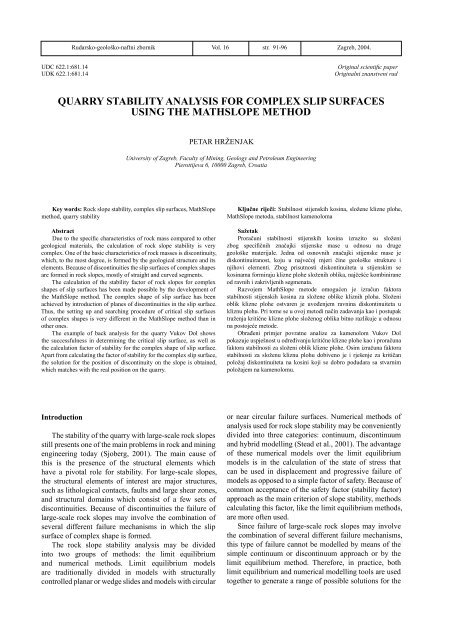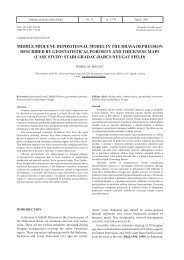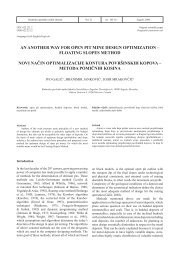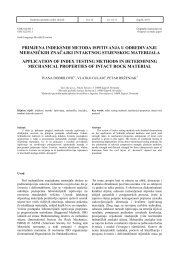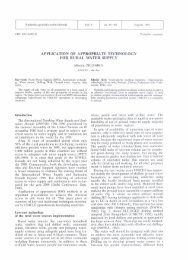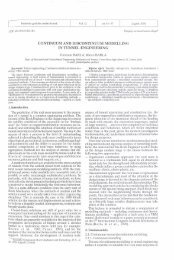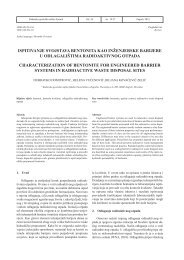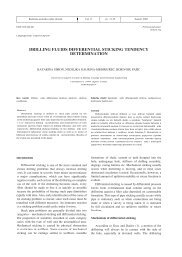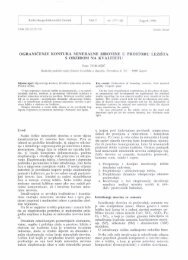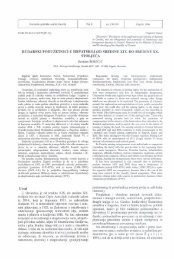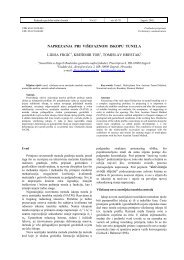quarry stability analysis for complex slip surfaces using the ...
quarry stability analysis for complex slip surfaces using the ...
quarry stability analysis for complex slip surfaces using the ...
Create successful ePaper yourself
Turn your PDF publications into a flip-book with our unique Google optimized e-Paper software.
Rudarsko-geološko-naftni zbornik Vol. 16 str. 91-96 Zagreb, 2004.<br />
UDC 622.1:681.14<br />
UDK 622.1:681.14<br />
Original scientific paper<br />
Originalni znanstveni rad<br />
QUARRY STABILITY ANALYSIS FOR COMPLEX SLIP SURFACES<br />
USING THE MATHSLOPE METHOD<br />
PETAR HRŽENJAK<br />
University of Zagreb, Faculty of Mining, Geology and Petroleum Engineering<br />
Pierottijeva 6, 10000 Zagreb, Croatia<br />
Key words: Rock slope <strong>stability</strong>, <strong>complex</strong> <strong>slip</strong> <strong>surfaces</strong>, MathSlope<br />
method, <strong>quarry</strong> <strong>stability</strong><br />
Abstract<br />
Due to <strong>the</strong> specific characteristics of rock mass compared to o<strong>the</strong>r<br />
geological materials, <strong>the</strong> calculation of rock slope <strong>stability</strong> is very<br />
<strong>complex</strong>. One of <strong>the</strong> basic characteristics of rock masses is discontinuity,<br />
which, to <strong>the</strong> most degree, is <strong>for</strong>med by <strong>the</strong> geological structure and its<br />
elements. Because of discontinuities <strong>the</strong> <strong>slip</strong> <strong>surfaces</strong> of <strong>complex</strong> shapes<br />
are <strong>for</strong>med in rock slopes, mostly of straight and curved segments.<br />
The calculation of <strong>the</strong> <strong>stability</strong> factor of rock slopes <strong>for</strong> <strong>complex</strong><br />
shapes of <strong>slip</strong> <strong>surfaces</strong> has been made possible by <strong>the</strong> development of<br />
<strong>the</strong> MathSlope method. The <strong>complex</strong> shape of <strong>slip</strong> surface has been<br />
achieved by introduction of planes of discontinuities in <strong>the</strong> <strong>slip</strong> surface.<br />
Thus, <strong>the</strong> setting up and searching procedure of critical <strong>slip</strong> <strong>surfaces</strong><br />
of <strong>complex</strong> shapes is very different in <strong>the</strong> MathSlope method than in<br />
o<strong>the</strong>r ones.<br />
The example of back <strong>analysis</strong> <strong>for</strong> <strong>the</strong> <strong>quarry</strong> Vukov Dol shows<br />
<strong>the</strong> successfulness in determining <strong>the</strong> critical <strong>slip</strong> surface, as well as<br />
<strong>the</strong> calculation factor of <strong>stability</strong> <strong>for</strong> <strong>the</strong> <strong>complex</strong> shape of <strong>slip</strong> surface.<br />
Apart from calculating <strong>the</strong> factor of <strong>stability</strong> <strong>for</strong> <strong>the</strong> <strong>complex</strong> <strong>slip</strong> surface,<br />
<strong>the</strong> solution <strong>for</strong> <strong>the</strong> position of discontinuity on <strong>the</strong> slope is obtained,<br />
which matches with <strong>the</strong> real position on <strong>the</strong> <strong>quarry</strong>.<br />
Ključne riječi: Stabilnost stijenskih kosina, složene klizne plohe,<br />
MathSlope metoda, stabilnost kamenoloma<br />
Sažetak<br />
Proračuni stabilnosti stijenskih kosina izrazito su složeni<br />
zbog specifičnih značajki stijenske mase u odnosu na druge<br />
geološke materijale. Jedna od osnovnih značajki stijenske mase je<br />
diskontinuiranost, koju u najvećoj mjeri čine geološke strukture i<br />
njihovi elementi. Zbog prisutnosti diskontinuiteta u stijenskim se<br />
kosinama <strong>for</strong>miraju klizne plohe složenih oblika, najčešće kombinirane<br />
od ravnih i zakrivljenih segmenata.<br />
Razvojem MathSlope metode omogućen je izračun faktora<br />
stabilnosti stijenskih kosina za složene oblike kliznih ploha. Složeni<br />
oblik klizne plohe ostvaren je uvođenjem ravnina diskontinuiteta u<br />
kliznu plohu. Pri tome se u ovoj metodi način zadavanja kao i postupak<br />
traženja kritične klizne plohe složenog oblika bitno razlikuje u odnosu<br />
na postojeće metode.<br />
Obrađeni primjer povratne analize za kamenolom Vukov Dol<br />
pokazuje uspješnost u određivanju kritične klizne plohe kao i proračuna<br />
faktora stabilnosti za složeni oblik klizne plohe. Osim izračuna faktora<br />
stabilnosti za složenu kliznu plohu dobiveno je i rješenje za kritičan<br />
položaj diskontinuiteta na kosini koji se dobro podudara sa stvarnim<br />
položajem na kamenolomu.<br />
Introduction<br />
The <strong>stability</strong> of <strong>the</strong> <strong>quarry</strong> with large-scale rock slopes<br />
still presents one of <strong>the</strong> main problems in rock and mining<br />
engineering today (Sjoberg, 2001). The main cause of<br />
this is <strong>the</strong> presence of <strong>the</strong> structural elements which<br />
have a pivotal role <strong>for</strong> <strong>stability</strong>. For large-scale slopes,<br />
<strong>the</strong> structural elements of interest are major structures,<br />
such as lithological contacts, faults and large shear zones,<br />
and structural domains which consist of a few sets of<br />
discontinuities. Because of discontinuities <strong>the</strong> failure of<br />
large-scale rock slopes may involve <strong>the</strong> combination of<br />
several different failure mechanisms in which <strong>the</strong> <strong>slip</strong><br />
surface of <strong>complex</strong> shape is <strong>for</strong>med.<br />
The rock slope <strong>stability</strong> <strong>analysis</strong> may be divided<br />
into two groups of methods: <strong>the</strong> limit equilibrium<br />
and numerical methods. Limit equilibrium models<br />
are traditionally divided in models with structurally<br />
controlled planar or wedge slides and models with circular<br />
or near circular failure <strong>surfaces</strong>. Numerical methods of<br />
<strong>analysis</strong> used <strong>for</strong> rock slope <strong>stability</strong> may be conveniently<br />
divided into three categories: continuum, discontinuum<br />
and hybrid modelling (Stead et al., 2001). The advantage<br />
of <strong>the</strong>se numerical models over <strong>the</strong> limit equilibrium<br />
models is in <strong>the</strong> calculation of <strong>the</strong> state of stress that<br />
can be used in displacement and progressive failure of<br />
models as opposed to a simple factor of safety. Because of<br />
common acceptance of <strong>the</strong> safety factor (<strong>stability</strong> factor)<br />
approach as <strong>the</strong> main criterion of slope <strong>stability</strong>, methods<br />
calculating this factor, like <strong>the</strong> limit equilibrium methods,<br />
are more often used.<br />
Since failure of large-scale rock slopes may involve<br />
<strong>the</strong> combination of several different failure mechanisms,<br />
this type of failure cannot be modelled by means of <strong>the</strong><br />
simple continuum or discontinuum approach or by <strong>the</strong><br />
limit equilibrium method. There<strong>for</strong>e, in practice, both<br />
limit equilibrium and numerical modelling tools are used<br />
toge<strong>the</strong>r to generate a range of possible solutions <strong>for</strong> <strong>the</strong>
92<br />
range of input parameters that exist <strong>for</strong> a particular site.<br />
With <strong>the</strong> aim of solving <strong>the</strong> rock slope <strong>stability</strong> problems<br />
more successfully, <strong>the</strong> numerical research in developing<br />
<strong>the</strong> estimation method named MathSlope has been<br />
undertaken (Hrženjak, 2004).<br />
The MathSlope method<br />
The method and algorithm named MathSlope has been<br />
developed with <strong>the</strong> aim of calculating <strong>the</strong> <strong>stability</strong> factor<br />
of rock slopes <strong>for</strong> <strong>complex</strong> shapes of <strong>slip</strong> <strong>surfaces</strong>. The<br />
algorithm MathSlope has been created by <strong>the</strong> program<br />
Ma<strong>the</strong>matica in <strong>the</strong> <strong>for</strong>m of an added package (Hrženjak<br />
et al., 2003). The setting up and searching procedure of<br />
critical <strong>slip</strong> surface of <strong>complex</strong> shape is very different in<br />
<strong>the</strong> MathSlope method than in o<strong>the</strong>r ones. The setting up<br />
of <strong>the</strong> <strong>slip</strong> surface is carried out in two steps. In <strong>the</strong> first<br />
step <strong>the</strong> basic shape of <strong>the</strong> <strong>slip</strong> surface is <strong>for</strong>med, whereas<br />
in <strong>the</strong> second, with <strong>the</strong> introduction of discontinuity<br />
<strong>surfaces</strong>, <strong>the</strong> <strong>complex</strong> shapes of <strong>the</strong> <strong>slip</strong> surface are<br />
Rud.-geol.-naft. zb., Vol. 16, Zagreb, 2004.<br />
P. Hrženjak: Quarry <strong>stability</strong> <strong>analysis</strong> <strong>for</strong> <strong>complex</strong> <strong>slip</strong> <strong>surfaces</strong>...<br />
created. The basic assumption in this method is that all<br />
<strong>slip</strong> <strong>surfaces</strong> have a concave shape.<br />
The <strong>slip</strong> surface is defined by <strong>the</strong> point of exit of <strong>the</strong><br />
<strong>slip</strong> surface at <strong>the</strong> toe of <strong>the</strong> slope, <strong>the</strong> angle of secant<br />
and angles of deviation of <strong>slip</strong> surface from secant on top<br />
and at <strong>the</strong> toe of <strong>the</strong> slope. These angles actually define<br />
tangents to <strong>the</strong> <strong>slip</strong> surface (fig. 1).<br />
The discontinuities can be introduced as “floating”<br />
and “positioned”. The “floating” discontinuities mean<br />
that discontinuities will be added to each <strong>slip</strong> surface at<br />
<strong>the</strong> point that has <strong>the</strong> same inclination as <strong>the</strong> inclination<br />
of <strong>the</strong> discontinuities. The discontinuities will be added<br />
to <strong>the</strong> <strong>slip</strong> surface in length of persistence that has been<br />
given as input data. The “positioned” discontinuity means<br />
that discontinuity surface will be added according to<br />
<strong>the</strong> position on <strong>the</strong> slope. The “floating” discontinuities<br />
refer to sets of discontinuities which represent structural<br />
domains, unlike <strong>the</strong> “positioned” ones, which refer to<br />
individual or major structures such as contacts, faults and<br />
shear zones.<br />
Figure 1. Setting up a <strong>complex</strong> shape of <strong>the</strong> <strong>slip</strong> surface<br />
Slika 1. Postava klizne plohe složenog oblika<br />
The procedure of searching <strong>for</strong> <strong>the</strong> critical <strong>slip</strong> surface<br />
can be carried out through setting up of a large number<br />
of assumed <strong>slip</strong> <strong>surfaces</strong> and <strong>the</strong> iterative method. In<br />
<strong>the</strong> first method one or more areas <strong>for</strong> <strong>the</strong> searching of<br />
a <strong>slip</strong> surface <strong>for</strong> every slope may be assigned. The area<br />
of searching comprises of <strong>the</strong> coordinates of <strong>the</strong> points<br />
on <strong>the</strong> top of <strong>the</strong> slope that assigns <strong>the</strong> range of angle<br />
deviation of <strong>the</strong> secant and point of exit of <strong>the</strong> <strong>slip</strong> surface.<br />
The shape of <strong>the</strong> <strong>slip</strong> surface starts from <strong>the</strong> straight line<br />
that actually presents <strong>the</strong> secant across different twisted<br />
shapes within <strong>the</strong>oretical possible angles of <strong>slip</strong> surface.<br />
The step of changes of all angles may be arbitrarily<br />
chosen. In this way <strong>the</strong> number of possible <strong>the</strong>oretical<br />
combinations of shapes of <strong>the</strong> <strong>slip</strong> <strong>surfaces</strong> may be<br />
generated. In <strong>the</strong> iterative method <strong>the</strong> shape and position<br />
of <strong>the</strong> <strong>slip</strong> surface is changed gradually until a minimum<br />
value of <strong>the</strong> <strong>stability</strong> factor is obtained. In combining<br />
<strong>the</strong>se two procedures critical <strong>slip</strong> surface of <strong>complex</strong><br />
shape can successfully be found. As in o<strong>the</strong>r methods <strong>the</strong><br />
critical <strong>slip</strong> surface is a <strong>slip</strong> surface with <strong>the</strong> lowest factor<br />
of <strong>stability</strong>.<br />
The <strong>stability</strong> factor, as in o<strong>the</strong>r methods, is defined as<br />
<strong>the</strong> ratio of <strong>the</strong> summation of <strong>the</strong> available resisting shear<br />
<strong>for</strong>ce (S r<br />
) along a <strong>slip</strong> surface to <strong>the</strong> summation of <strong>the</strong><br />
mobilized shear <strong>for</strong>ce along a <strong>slip</strong> surface (S m<br />
).<br />
.<br />
(1)
Rud.-geol.-naft. zb., Vol. 16, Zagreb, 2004.<br />
P. Hrženjak: Quarry <strong>stability</strong> <strong>analysis</strong> <strong>for</strong> <strong>complex</strong> <strong>slip</strong> <strong>surfaces</strong>...<br />
The normal stress (σ n<br />
) and <strong>the</strong> mobilized shear stress<br />
(τ m<br />
) at <strong>the</strong> point of <strong>slip</strong> surface are computed <strong>using</strong> <strong>the</strong><br />
following equations:<br />
(2)<br />
3)<br />
93<br />
this part of <strong>the</strong> <strong>quarry</strong>, caused <strong>the</strong> plane sliding. However,<br />
based on observation, <strong>the</strong> sliding most probably occurred<br />
along a <strong>complex</strong> <strong>slip</strong> surface, first as a plain failure along<br />
<strong>the</strong> foliated plane, and <strong>the</strong>n along curved <strong>surfaces</strong> through<br />
<strong>the</strong> rock mass.<br />
After that a number of investigation and back <strong>analysis</strong><br />
have been made with <strong>the</strong> aim of establishing rock mass<br />
properties.<br />
The developed <strong>for</strong>ehead of land-slide is <strong>for</strong>med by a<br />
surface with <strong>the</strong> orientation of 150/70-80° and a depth<br />
of over 20 m as is obvious on picture (fig. 2) and profile<br />
(fig. 3).<br />
where σ x<br />
and σ y<br />
are total stresses in x and y direction<br />
respectively, τ xy<br />
is shear stress and θ is an angle measured<br />
from positive x axis to <strong>the</strong> line of application of <strong>the</strong><br />
normal stress at <strong>the</strong> point of <strong>slip</strong> surface.<br />
The state of stress <strong>for</strong> <strong>the</strong> model must be estimated<br />
by a numerical program such as <strong>the</strong> finite element or<br />
<strong>the</strong> finite difference method. After estimation, <strong>the</strong> state<br />
of stress is introduced in <strong>the</strong> model of slope <strong>stability</strong><br />
by a specially created function. After that, some of <strong>the</strong><br />
interpolation functions of <strong>the</strong> program Ma<strong>the</strong>matica are<br />
used <strong>for</strong> obtaining a continuous field of stresses.<br />
The MathSlope algorithm consists of accessory<br />
functions such as HoekBrown and Barton, which have<br />
been created <strong>for</strong> <strong>the</strong> estimation of rock mass strength<br />
and shear strength of rock joints according to <strong>the</strong> Hoek-<br />
Brown (Hoek et al., 2002) and Barton (Barton, 1976)<br />
failure criterion respectively. The shear strength <strong>for</strong> <strong>the</strong><br />
<strong>complex</strong> shape of <strong>the</strong> <strong>slip</strong> surface is controlled by <strong>the</strong><br />
shear strength of rock mass at <strong>the</strong> points of curved portion<br />
and by <strong>the</strong> shear strength of discontinuity at <strong>the</strong> points of<br />
straight portion of <strong>the</strong> <strong>slip</strong> surface. In this way <strong>the</strong> Hoek-<br />
Brown failure criterion <strong>for</strong> rock mass and Barton failure<br />
criterion <strong>for</strong> discontinuity may be directly applied in <strong>the</strong><br />
strength model of <strong>the</strong> <strong>slip</strong> surface.<br />
Case study <strong>analysis</strong><br />
The <strong>quarry</strong> Vukov Dol<br />
The <strong>quarry</strong> of marble-like limestone Vukov Dol is<br />
placed on <strong>the</strong> South-Eastern hillsides of Medvednica,<br />
about 3 km north from <strong>the</strong> place Kašina. The geological<br />
structures of <strong>the</strong> <strong>quarry</strong> are very <strong>complex</strong> because of <strong>the</strong><br />
genetic as well as postgenetic processes. Metamorphic<br />
processes have conditioned <strong>the</strong> origin of marble-like<br />
limestone, marble and phyllite. The rock mass is<br />
subsequently intersected with many faults and joints as a<br />
result of a number of tectonic processes.<br />
Throughout exploitation <strong>the</strong> sliding of rock mass<br />
appeared several times. The last large sliding happened<br />
2000 when over 350.000 m 3 of material collapsed. The<br />
main cause of instabilities, as <strong>the</strong>n considered, were <strong>the</strong><br />
foliated planes with <strong>the</strong> orientation of 158/42° which, in<br />
Figure 2. Forehead of land-slide on <strong>the</strong> <strong>quarry</strong> Vukov Dol<br />
Slika 2. Čelo klizišta na kamenolomu Vukov Dol<br />
The slope <strong>stability</strong> back <strong>analysis</strong> was per<strong>for</strong>med by<br />
<strong>the</strong> MathSlope algorithm <strong>using</strong> <strong>the</strong> Hoek-Brown failure<br />
criterion <strong>for</strong> rock mass and Barton failure criterion <strong>for</strong><br />
discontinuity which have been directly applied in <strong>the</strong><br />
strength model of <strong>the</strong> <strong>slip</strong> surface. The average properties<br />
of rock mass were estimated at: density of 2690 kg/m 3 ,<br />
intact uniaxial compressive strength σ ci<br />
=54 MPa, constant<br />
m i<br />
=10 and geological strength index GSI=27÷29. For<br />
<strong>the</strong> discontinuities <strong>the</strong> average value of <strong>the</strong> joint rough<br />
coefficient JRC of 7÷9 and <strong>the</strong> joint wall compressive<br />
strength JCS of 20 MPa were estimated. Figure 3 presents<br />
<strong>the</strong> comparison of <strong>slip</strong> <strong>surfaces</strong> of <strong>complex</strong> and general<br />
shapes with <strong>the</strong> slope be<strong>for</strong>e and after break down. The<br />
plain of discontinuity on <strong>the</strong> <strong>slip</strong> surface is marked with<br />
a dashed line.<br />
The solution <strong>for</strong> <strong>the</strong> <strong>complex</strong> shape of <strong>the</strong> <strong>slip</strong><br />
surface with discontinuity, in this case foliated planes,<br />
very well coincides with <strong>the</strong> real <strong>slip</strong> surface on <strong>the</strong><br />
slope. However, it is important to notice that <strong>the</strong> solution<br />
<strong>for</strong> <strong>the</strong> general <strong>slip</strong> surface without discontinuity is also<br />
possible. Consequently, <strong>the</strong> real shape and position of <strong>the</strong><br />
critical <strong>slip</strong> surface is most probably between <strong>the</strong>se two<br />
solutions and it depends on <strong>the</strong> real values of rock mass<br />
and discontinuity properties.
94<br />
Rud.-geol.-naft. zb., Vol. 16, Zagreb, 2004.<br />
P. Hrženjak: Quarry <strong>stability</strong> <strong>analysis</strong> <strong>for</strong> <strong>complex</strong> <strong>slip</strong> <strong>surfaces</strong>...<br />
<br />
<br />
<br />
<br />
<br />
<br />
<br />
<br />
<br />
<br />
<br />
Figure 3. Profile of <strong>the</strong> <strong>quarry</strong> Vukov Dol<br />
Slika 3. Profil kamenoloma Vukov Dol<br />
The <strong>quarry</strong> Pregrada<br />
The second example of <strong>the</strong> slope <strong>stability</strong> <strong>analysis</strong><br />
<strong>for</strong> <strong>the</strong> project solution was carried out <strong>for</strong> <strong>the</strong> <strong>quarry</strong><br />
Pregrada. The <strong>quarry</strong> Pregrada is placed in <strong>the</strong> North-<br />
West part of <strong>the</strong> Republic Croatia. The rock mass of <strong>the</strong><br />
<strong>quarry</strong> Pregrada is mostly Triassic dolomite. The total<br />
height of <strong>the</strong> <strong>quarry</strong> amounts to about 210 m. Based<br />
on <strong>the</strong> geological characteristics of <strong>the</strong> rock mass, <strong>the</strong><br />
<strong>quarry</strong> is divided in two regions. The first region, marked<br />
as <strong>the</strong> Dolomite I, stretches from <strong>the</strong> elevation +205 to<br />
approximately +310 m and <strong>the</strong> second region, marked<br />
as Dolomite II, stretches from +310 to +415 m. The<br />
geometry of <strong>the</strong> slope is illustrated in figs. 4 and 5 that<br />
show <strong>the</strong> 210 m high slope with fourteen 15 m high<br />
benches. The inclination of <strong>the</strong> individual bench face is<br />
65° and <strong>the</strong> overall slope angle is about 42,6°.<br />
Dolomite I is represented by dark grey dolomite with<br />
a density of 2769 kg/m3, GSI=49, σ ci<br />
=60 MPa and m i<br />
=11.<br />
Dolomite II is represented by light grey dolomite, light<br />
yellow lime-dolomite and dolomite breccia with a density<br />
of 2769 kg/m3, GSI=53, σ ci<br />
=88 MPa and m i<br />
=8. By <strong>the</strong><br />
Hoek-Brown failure criterion <strong>the</strong> average cohesion of<br />
0,679 MPa and <strong>the</strong> degree of internal friction of 26,6° <strong>for</strong><br />
Dolomite I, as well as <strong>the</strong> average cohesion of 0,844 MPa<br />
and <strong>the</strong> degree of internal friction of 29° <strong>for</strong> Dolomite II<br />
were obtained.<br />
The discontinuities which can influence <strong>the</strong> <strong>stability</strong> of<br />
<strong>the</strong> <strong>quarry</strong> are: discontinuity with an angle of inclination<br />
of 31°, <strong>for</strong> <strong>the</strong> first region, Dolomite I, and discontinuity<br />
with an angle of inclination of 43°, <strong>for</strong> <strong>the</strong> second region,<br />
Dolomite II. The characteristics of <strong>the</strong> first discontinuity<br />
are JRC=4÷8, JCS=32÷35 MPa and ϕ b<br />
=30°. The<br />
characteristics of <strong>the</strong> second discontinuity are JRC=8÷12,<br />
JCS=82÷88 MPa and ϕ b<br />
=30°. The persistence of <strong>the</strong><br />
discontinuities varies from 20 to 30 m, but may be up to<br />
50 m in special cases.<br />
The slope <strong>stability</strong> <strong>analysis</strong> has been per<strong>for</strong>med<br />
<strong>for</strong> a number of cases. For <strong>the</strong> first case, <strong>the</strong> <strong>stability</strong><br />
<strong>analysis</strong> was carried out without any discontinuities and<br />
<strong>the</strong> factor of safety of 1,876 was obtained (fig. 4). For<br />
<strong>the</strong> second case, <strong>the</strong> <strong>stability</strong> <strong>analysis</strong> was carried out<br />
with discontinuities and <strong>the</strong> factor of safety of 1,854<br />
was obtained. It is obvious that <strong>the</strong>re is no significant<br />
difference in <strong>the</strong> obtained values of safety factors <strong>for</strong> <strong>the</strong>se<br />
cases. This is due to <strong>the</strong> relatively good characteristics<br />
and small lengths of discontinuities, but <strong>for</strong> <strong>the</strong> reduced<br />
shear strength of discontinuities, <strong>for</strong> example, <strong>for</strong> <strong>the</strong><br />
cohesion of 10 kPa and angle of internal friction of 17°<br />
and length of discontinuity of 50 m, <strong>the</strong> factor of <strong>stability</strong><br />
falls to 1,576 (fig. 5).<br />
Ano<strong>the</strong>r important feature of <strong>the</strong>se analyses is<br />
that changes of characteristics of rock mass and<br />
discontinuities, beside <strong>the</strong>ir influence on <strong>the</strong> safety factor,<br />
have a significant influence on <strong>the</strong> position of <strong>the</strong> critical<br />
<strong>slip</strong> surface. This is obvious from shapes of <strong>the</strong> <strong>slip</strong><br />
surface in figs. 4 and 5.
Rud.-geol.-naft. zb., Vol. 16, Zagreb, 2004.<br />
P. Hrženjak: Quarry <strong>stability</strong> <strong>analysis</strong> <strong>for</strong> <strong>complex</strong> <strong>slip</strong> <strong>surfaces</strong>...<br />
95<br />
<br />
<br />
<br />
<br />
<br />
<br />
<br />
<br />
<br />
<br />
<br />
Figure 4. Solution <strong>for</strong> <strong>the</strong> slope <strong>stability</strong> <strong>analysis</strong> without discontinuity<br />
Slika 4. Rješenje analize stabilnosti bez diskontinuiteta<br />
<br />
<br />
<br />
<br />
<br />
<br />
<br />
<br />
<br />
<br />
<br />
Figure 5. Solution <strong>for</strong> <strong>the</strong> slope <strong>stability</strong> <strong>analysis</strong> with discontinuities<br />
Slika 5. Rješenje analize stabilnosti s diskontinuitetima
96<br />
Conclusion<br />
The MathSlope method has been developed with <strong>the</strong><br />
aim of analysing <strong>the</strong> large-scale rock slope <strong>stability</strong>. The<br />
basic characteristic of <strong>the</strong> method is <strong>the</strong> calculation of<br />
<strong>the</strong> factor of <strong>stability</strong> and <strong>the</strong> search <strong>for</strong> <strong>the</strong> critical <strong>slip</strong><br />
surface of <strong>complex</strong> shape, namely <strong>the</strong> combination of<br />
<strong>the</strong> failure through <strong>the</strong> rock mass and failure along <strong>the</strong><br />
surface of discontinuity. The algorithm makes it possible<br />
to directly apply <strong>the</strong> Hoek-Brown and Barton’s failure<br />
criterion in <strong>the</strong> method of calculation.<br />
The analysed examples show how successful <strong>the</strong><br />
MathSlope method is in determining <strong>the</strong> critical <strong>slip</strong><br />
surface as well as in calculating <strong>the</strong> factor of <strong>stability</strong> <strong>for</strong><br />
<strong>complex</strong> shapes of <strong>slip</strong> <strong>surfaces</strong>. Apart from calculating<br />
<strong>the</strong> factor of <strong>stability</strong> <strong>for</strong> <strong>complex</strong> <strong>slip</strong> surface, <strong>the</strong><br />
solution <strong>for</strong> <strong>the</strong> position of discontinuity on slope is<br />
obtained, which coincides with <strong>the</strong> real position on <strong>the</strong><br />
slope. The presented results show that <strong>the</strong> MathSlope<br />
method can be well applied in <strong>the</strong> procedure of <strong>quarry</strong><br />
<strong>stability</strong> calculation, which is a good reason <strong>for</strong> <strong>the</strong><br />
fur<strong>the</strong>r development of <strong>the</strong> method.<br />
Rud.-geol.-naft. zb., Vol. 16, Zagreb, 2004.<br />
P. Hrženjak: Quarry <strong>stability</strong> <strong>analysis</strong> <strong>for</strong> <strong>complex</strong> <strong>slip</strong> <strong>surfaces</strong>...<br />
References<br />
Barton, N. (1976): The shear strength of rock and rock joints.<br />
International Journal of Rock Mechanics, Mining Sciences &<br />
Geomechanical Abstracts. Vol. 13, pp. 255-279.<br />
Hoek, E., Carranza-Torres, C., Corkum, B. (2002): Hoek-Brown failure<br />
criterion-2002 edition. Rocscience Inc., http://www.rocscience.com,<br />
Toronto.<br />
Hrženjak, P. (2004): Determination of Complex Slip Surfaces and<br />
Calculation procedures of rock slopes <strong>stability</strong>. Doctoral Thesis.<br />
Faculty of Mining, Geology and Petroleum Engineering, University<br />
of Zagreb, Zagreb.<br />
Hrženjak, P., Vujec, S., Kvasnička, P. (2003): Application of <strong>the</strong><br />
Program Ma<strong>the</strong>matica in Developing Rock Slope Stability<br />
Analyses Methods. Fourth International Conference on Computer<br />
Application in <strong>the</strong> Minerals Industries. September 8-10, Calgary,<br />
Alberta, Canada.<br />
Sjoberg, J. (2001): Analysis of Large Scale Rock Slopes. Doctoral<br />
Thesis. Lulea University of Technology, Lulea.<br />
Stead, D., Eberhardt, E., Coggen, J., Benko, B. (2001): Advanced<br />
numerical techniques in rock slope <strong>stability</strong> <strong>analysis</strong> – applications<br />
and limitations. Landslides – Causes, Impacts and Countermeasures.<br />
Davos 17-21 June 2001, pp. 615-624.<br />
Received: 1.5.2004<br />
Accepted: 24.9.2004.


